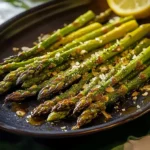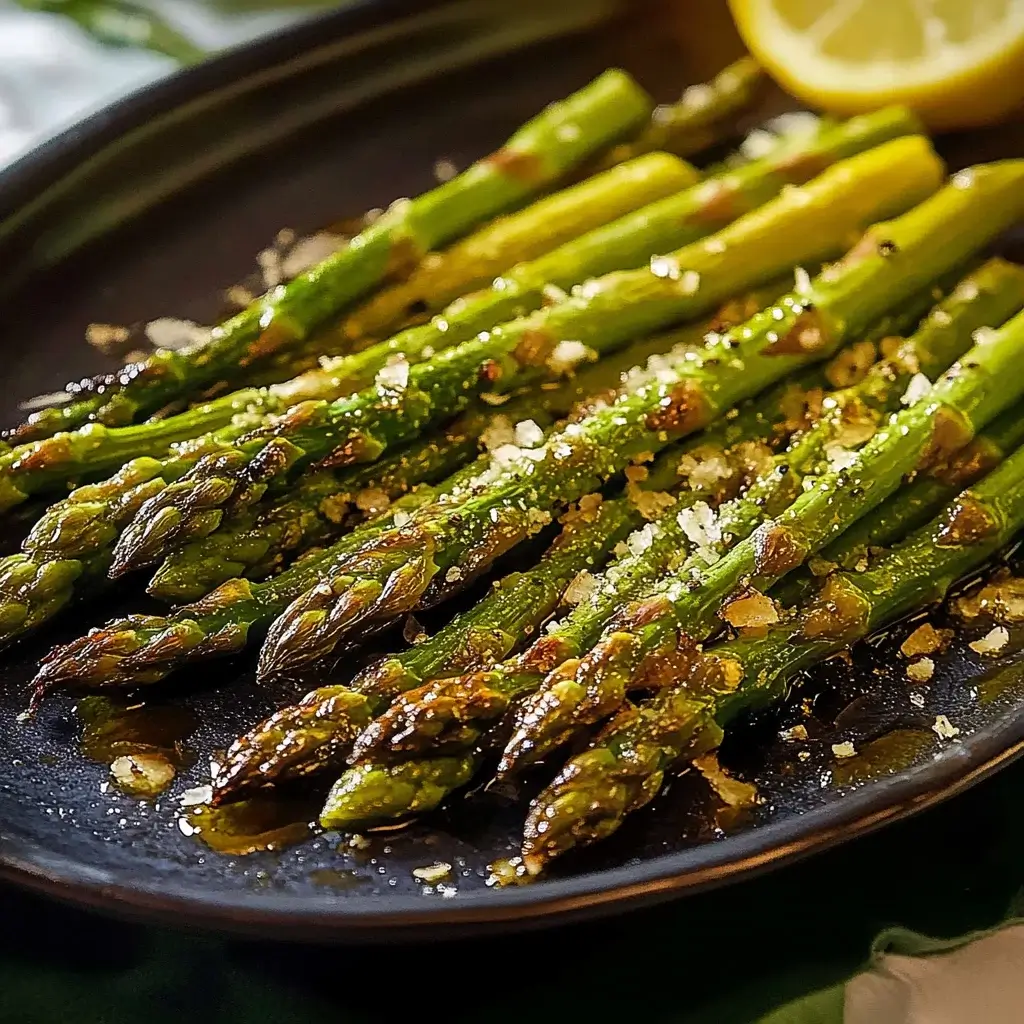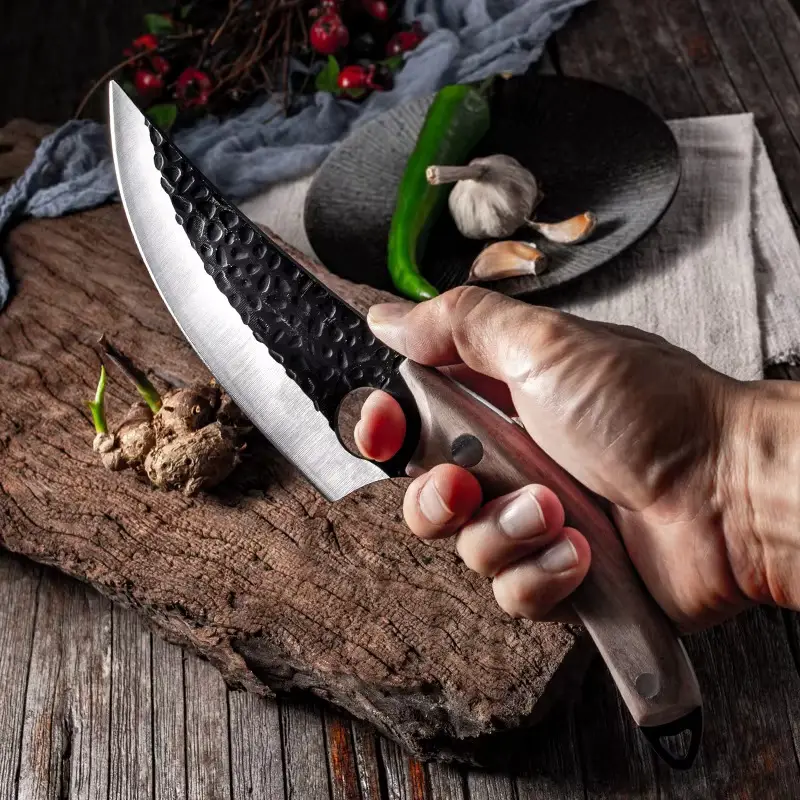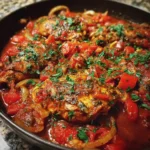In our home, weeknight dinners are often a dance between speed and flavor. Like many families, we crave meals that are both healthy and delicious, but also manageable after a long day. Roasted asparagus with olive oil has become our unsung hero in this culinary balancing act. It started as a simple side dish experiment, born out of a desire to incorporate more greens into our diet. Honestly, I wasn’t expecting much fanfare – vegetables, especially green ones, can sometimes be met with groans. But from the very first bite, this recipe was a revelation. The asparagus, transformed in the oven with just olive oil, salt, and pepper, emerged tender-crisp, with a subtle sweetness that even my pickiest eater couldn’t resist. The simplicity is its genius. It’s proof that sometimes, the best flavors come from letting quality ingredients shine, unmasked by complicated sauces or lengthy preparations. Now, roasted asparagus with olive oil is a regular feature on our table, pairing beautifully with everything from grilled chicken to baked salmon, or even as a vibrant addition to a vegetarian pasta dish. It’s become a staple not just for its taste, but for its sheer ease and the way it elevates even the simplest meal into something special. If you’re looking for a vegetable side dish that’s effortlessly elegant and undeniably delicious, look no further. This roasted asparagus recipe is about to become your new best friend in the kitchen.
Ingredients: The Essence of Simplicity
This recipe champions minimalism, relying on just a handful of high-quality ingredients to deliver maximum flavor. Each component plays a crucial role in creating the perfect roasted asparagus.
- Fresh Asparagus: (1 pound) – The star of the show! Opt for bright green, firm spears with tightly closed tips. Freshness is key for optimal flavor and texture. You can choose between thicker or thinner spears; thicker spears will require slightly longer roasting time, while thinner spears cook more quickly and become wonderfully crisp. Look for asparagus that feels heavy for its size, indicating good hydration and freshness.
- Extra Virgin Olive Oil: (2-3 tablespoons) – The foundation of flavor and the key to achieving that perfect roasted texture. Extra virgin olive oil not only adds a rich, fruity flavor but also helps the asparagus to caramelize beautifully in the oven. Choose a good quality olive oil as its flavor will be prominent in this simple recipe.
- Sea Salt or Kosher Salt: (To taste) – Enhances the natural sweetness of the asparagus and balances the richness of the olive oil. Sea salt or kosher salt are preferred for their clean taste and coarser texture, which helps to distribute the seasoning evenly.
- Freshly Ground Black Pepper: (To taste) – Adds a subtle warmth and a touch of spice, complementing the earthy notes of the asparagus and the fruitiness of the olive oil. Freshly ground pepper provides a more aromatic and vibrant flavor compared to pre-ground pepper.
Instructions: Effortless Steps to Perfection
Roasting asparagus is incredibly straightforward, making it an ideal recipe for busy weeknights or when you want a delicious side dish without spending hours in the kitchen. Follow these simple steps for perfectly roasted asparagus every time.
- Preheat Your Oven to 400°F (200°C): Proper oven temperature is crucial for roasting vegetables. Preheating ensures that the oven is at the correct temperature before you place the asparagus inside, allowing it to cook evenly and develop that desirable tender-crisp texture. A hot oven is essential for caramelization and preventing the asparagus from becoming soggy.
- Prepare the Asparagus: Start by washing the asparagus spears under cold running water to remove any dirt or grit. Pat them dry with a clean kitchen towel or paper towels. Drying the asparagus is important as it helps the olive oil adhere better and promotes browning in the oven. Next, trim the woody ends of the asparagus. The bottom inch or two of the asparagus stalk can be tough and fibrous. You can either snap off the ends where they naturally break, or you can cut them off with a knife. Snapping often results in less waste, as the asparagus will naturally break at the point where the tender part begins.
- Toss with Olive Oil: Place the trimmed asparagus spears in a bowl. Drizzle with 2-3 tablespoons of extra virgin olive oil. Use your hands or tongs to toss the asparagus until it is evenly coated with the oil. Ensure that each spear is lightly glistening with olive oil, as this will prevent them from drying out and help them roast beautifully. Even coating is key for consistent cooking and flavor.
- Season Generously: Sprinkle the asparagus with sea salt or kosher salt and freshly ground black pepper. Don’t be shy with the seasoning – asparagus can handle a good amount of salt and pepper. Toss again to ensure the seasoning is evenly distributed. Taste a single spear (raw) to gauge if you’ve added enough salt. Remember, seasoning at this stage is crucial for flavorful roasted asparagus; you can always add more salt after roasting, but it’s best to season properly before cooking.
- Arrange on a Baking Sheet: Spread the seasoned asparagus in a single layer on a baking sheet. Avoid overcrowding the pan, as this will cause the asparagus to steam rather than roast, resulting in soggy spears. If necessary, use two baking sheets to ensure ample space between the spears. Roasting in a single layer allows for proper air circulation around each spear, promoting even cooking and browning.
- Roast in the Preheated Oven: Place the baking sheet in the preheated oven and roast for 12-15 minutes, or until the asparagus is tender-crisp and lightly browned. The roasting time may vary slightly depending on the thickness of your asparagus spears and your oven. Start checking for doneness around 12 minutes. You want the asparagus to be bright green and slightly tender but still retain a bit of snap. Avoid overcooking, as it will become mushy.
- Check for Doneness: To check if the asparagus is done, pierce a spear with a fork. It should be easily pierced but still have a slight resistance. The tips should be slightly browned and crisp, and the stalks should be tender but not limp. If you prefer softer asparagus, roast for a couple more minutes; for crispier asparagus, roast slightly less.
- Serve Immediately: Once roasted to perfection, remove the asparagus from the oven and serve immediately. Roasted asparagus is best enjoyed hot, when it’s at its peak of flavor and texture. You can add a squeeze of fresh lemon juice just before serving for a bright, zesty finish, if desired.
Nutrition Facts: A Healthy and Delicious Choice
Roasted asparagus with olive oil is not only delicious but also a nutritional powerhouse. This simple side dish is packed with vitamins, minerals, and fiber, making it a healthy addition to any meal. Please note that nutritional values are approximate and can vary based on specific ingredients and serving sizes.
Serving Size: Approximately 1 cup (about 4-5 spears)
Servings per Recipe: 4
- Calories per Serving: Approximately 80-100 kcal
- Vitamin K: Excellent source – Asparagus is incredibly rich in Vitamin K, essential for blood clotting and bone health.
- Vitamin C: Good source – Provides a good amount of Vitamin C, a powerful antioxidant that supports immune function and skin health.
- Folate (Vitamin B9): Good source – Asparagus is a good source of folate, important for cell growth and development, especially crucial during pregnancy.
- Fiber: Moderate source – Contributes to daily fiber intake, aiding in digestion and promoting gut health.
- Low in Fat: Primarily healthy fats from olive oil – The fat content is mainly from the healthy monounsaturated fats in olive oil, beneficial for heart health.
- Sodium: Low (depending on salt added) – Sodium content is relatively low, especially if you are mindful of the amount of salt you add.
Roasted asparagus is naturally low in calories and carbohydrates while being rich in micronutrients, making it an excellent choice for those looking to eat healthily and increase their vegetable intake.
Preparation Time: Quick and Convenient
One of the greatest advantages of roasted asparagus is its speed and ease of preparation. From start to finish, this recipe is incredibly efficient, perfect for busy individuals and weeknight meals.
- Prep Time: 5-7 minutes – This includes washing the asparagus, trimming the ends, and tossing it with olive oil and seasonings. The minimal prep work makes this recipe incredibly convenient.
- Cook Time: 12-15 minutes – Roasting in a preheated oven takes just a short amount of time, ensuring the asparagus is cooked to tender-crisp perfection without a lengthy wait.
- Total Time: Approximately 17-22 minutes – From the moment you start prepping to when you can serve this delicious side dish, it’s all done in under 25 minutes.
Roasted asparagus with olive oil is a testament to how delicious and healthy meals can be both quick and easy to prepare. It’s an ideal choice for those seeking nutritious and flavorful side dishes without spending excessive time in the kitchen.
How to Serve: Versatile and Delicious
Roasted asparagus with olive oil is incredibly versatile and pairs beautifully with a wide variety of dishes. Its delicate flavor and tender-crisp texture make it a welcome addition to countless meals. Here are some delightful ways to serve roasted asparagus:
- As a Side Dish for Main Courses:
- Grilled or Baked Protein: Roasted asparagus is a classic pairing with grilled chicken, steak, salmon, or shrimp. Its fresh, green flavor complements the richness of the protein perfectly.
- Vegetarian Mains: Serve alongside vegetarian dishes like lentil loaf, tofu steaks, or hearty grain bowls for a balanced and satisfying meal.
- Pasta Dishes: Add roasted asparagus to pasta primavera, creamy pesto pasta, or lemon garlic pasta for a boost of flavor and nutrients.
- In Salads:
- Warm Asparagus Salad: Toss warm roasted asparagus with mixed greens, cherry tomatoes, crumbled feta cheese, and a lemon vinaigrette for a vibrant and flavorful salad.
- Asparagus and Grain Salad: Combine cooled roasted asparagus with quinoa, farro, or couscous, along with roasted red peppers, chickpeas, and a tahini dressing for a hearty and nutritious grain salad.
- In Egg Dishes:
- Asparagus Frittata or Omelette: Incorporate chopped roasted asparagus into frittatas, omelettes, or quiches for a flavorful and nutritious breakfast or brunch option.
- Eggs Benedict with Asparagus: Replace the traditional ham with roasted asparagus for a lighter and vegetarian-friendly Eggs Benedict variation.
- As an Appetizer or Snack:
- Asparagus with Dips: Serve roasted asparagus spears chilled or at room temperature with dips like hummus, aioli, or a creamy lemon-dill dip for a healthy and elegant appetizer.
- Asparagus and Prosciutto Wraps (Vegetarian option: Vegan Prosciutto): Wrap roasted asparagus spears with prosciutto (or vegetarian/vegan prosciutto alternative) for a simple and flavorful appetizer.
- Pizza or Flatbread Topping:
- Asparagus and Goat Cheese Pizza: Add roasted asparagus to homemade or store-bought pizza crusts along with goat cheese, mozzarella, and a drizzle of balsamic glaze for a gourmet pizza topping.
- Asparagus and Ricotta Flatbread: Top flatbread with ricotta cheese, roasted asparagus, and a sprinkle of red pepper flakes for a delicious and easy flatbread appetizer or light meal.
Additional Tips for Perfect Roasted Asparagus
While roasted asparagus with olive oil is incredibly simple, a few key tips can elevate your dish from good to outstanding. Here are eight essential tips to ensure perfectly roasted asparagus every time:
- Don’t Overcrowd the Baking Sheet: Ensure the asparagus spears are arranged in a single layer on the baking sheet. Overcrowding will cause them to steam instead of roast, resulting in soggy asparagus. Use two baking sheets if necessary to give the asparagus enough space. Proper spacing allows for air circulation, which is crucial for achieving that desirable crispiness and browning.
- Use High Heat for Crispiness: Roasting asparagus at a high temperature (400°F/200°C) is key to getting those beautifully browned and slightly crispy tips while keeping the stalks tender-crisp. High heat promotes caramelization and prevents the asparagus from becoming mushy.
- Trim the Woody Ends Properly: Trimming the tough, woody ends of the asparagus is essential for a pleasant eating experience. The bottom inch or two of the stalk is often fibrous and less palatable. Snap or cut off the ends to ensure you’re only roasting the tender parts of the asparagus.
- Fresh Asparagus is Best: For the best flavor and texture, use fresh, in-season asparagus. Look for spears that are firm, bright green, and have tightly closed tips. Fresh asparagus will have a sweeter, more delicate flavor and a more satisfying texture when roasted compared to older or less fresh asparagus.
- Adjust Seasoning to Taste: While salt and pepper are the foundation, don’t be afraid to experiment with other seasonings. Garlic powder, onion powder, red pepper flakes, or dried herbs like thyme or rosemary can add extra layers of flavor. Taste a raw spear after seasoning to ensure you’ve added enough salt and pepper before roasting.
- Experiment with Flavors After Roasting: While simple olive oil, salt, and pepper are delicious, you can enhance the flavor of your roasted asparagus even further after it comes out of the oven. A squeeze of fresh lemon juice, a sprinkle of grated Parmesan cheese (vegetarian option), a drizzle of balsamic glaze, or a sprinkle of toasted pine nuts can all add delightful finishing touches.
- Roast to Tender-Crisp Perfection: The goal is to roast the asparagus until it is tender but still has a slight bite. Overcooked asparagus becomes limp and mushy, while undercooked asparagus can be tough. Check for doneness around 12 minutes and adjust the roasting time based on the thickness of your spears and your desired level of tenderness.
- Serve Immediately for Best Texture: Roasted asparagus is best enjoyed immediately after cooking when it’s at its peak of flavor and texture. As it cools, it can lose some of its crispness. If you need to keep it warm for a short period, loosely tent it with foil, but avoid covering it tightly, which can make it steam and become soggy.
Frequently Asked Questions (FAQ) About Roasted Asparagus
Here are some common questions and answers to help you master the art of roasting asparagus and address any queries you might have:
Q1: Can I use frozen asparagus for roasting?
A: While fresh asparagus is highly recommended for roasting due to its superior texture and flavor, you can roast frozen asparagus in a pinch. However, frozen asparagus tends to release more moisture, which can prevent browning and result in a slightly softer texture. To roast frozen asparagus, do not thaw it first. Toss it with olive oil and seasonings and roast it at 425°F (220°C) for about 15-20 minutes, or until tender-crisp. Spread it in a single layer and ensure the oven is hot to help evaporate excess moisture.
Q2: How do I store leftover roasted asparagus?
A: Store leftover roasted asparagus in an airtight container in the refrigerator for up to 3-4 days. While it won’t be as crisp as freshly roasted asparagus, it can still be enjoyed cold in salads or reheated.
Q3: Can I roast asparagus in advance and reheat it?
A: Roasted asparagus is best enjoyed fresh. Reheating can make it lose its crispness and become softer. If you need to prepare it ahead of time, roast it slightly underdone and then gently reheat it in a skillet or oven at a low temperature (around 300°F/150°C) for a few minutes just before serving. However, for optimal texture, roasting just before serving is always recommended.
Q4: What are some other seasonings I can use besides salt and pepper?
A: Roasted asparagus is a blank canvas for flavor! Try these seasoning variations:
* Garlic and Parmesan: Toss with garlic powder before roasting, and sprinkle with grated Parmesan cheese after roasting (vegetarian option).
* Lemon and Herbs: Add lemon zest and dried herbs like thyme, rosemary, or oregano before roasting, and finish with a squeeze of fresh lemon juice after roasting.
* Red Pepper Flakes: Add a pinch of red pepper flakes for a touch of heat.
* Balsamic Glaze: Drizzle with balsamic glaze after roasting for a sweet and tangy finish.
* Everything Bagel Seasoning: Sprinkle with everything bagel seasoning for a savory and crunchy topping.
Q5: How do I know when asparagus is perfectly roasted?
A: Perfectly roasted asparagus should be tender-crisp. The tips should be slightly browned and crispy, and the stalks should be tender but still have a slight bite. Pierce a spear with a fork; it should be easily pierced but not mushy. Avoid overcooking, as it will become limp and lose its appealing texture.
Q6: Can I roast asparagus with other vegetables?
A: Yes, roasting asparagus with other vegetables is a great way to create a flavorful and colorful side dish. Vegetables that roast well alongside asparagus include:
* Bell peppers: Add diced bell peppers for sweetness and color.
* Red onion: Quartered red onion adds a savory and slightly sweet note.
* Cherry tomatoes: Cherry tomatoes burst and become sweet and juicy when roasted.
* Mushrooms: Sliced mushrooms add an earthy flavor.
* Broccoli or Brussels sprouts: These cruciferous vegetables roast well with asparagus.
Q7: Is roasted asparagus healthy?
A: Yes, roasted asparagus is very healthy! It’s low in calories and fat, and a good source of vitamins K, C, and folate, as well as fiber. The olive oil adds healthy monounsaturated fats. Roasted asparagus is a nutrient-dense and delicious way to incorporate more vegetables into your diet.
Q8: Can I use a different oil instead of olive oil?
A: Yes, you can use other oils for roasting asparagus, although olive oil is often preferred for its flavor and health benefits. Other good options include:
* Avocado oil: Has a high smoke point and a neutral flavor.
* Coconut oil: Adds a subtle coconut flavor, especially good if you want a slightly different taste profile.
* Vegetable oil or canola oil: Neutral oils that work well for roasting, but lack the flavor and potential health benefits of olive or avocado oil.
Roasted asparagus with olive oil is truly a kitchen staple – simple, healthy, and incredibly delicious. With these tips and answers, you’re well-equipped to make perfect roasted asparagus every time, transforming this humble vegetable into a star side dish that everyone will love.
Print
Roasted Asparagus with Olive Oil
Ingredients
This recipe champions minimalism, relying on just a handful of high-quality ingredients to deliver maximum flavor. Each component plays a crucial role in creating the perfect roasted asparagus.
- Fresh Asparagus: (1 pound) – The star of the show! Opt for bright green, firm spears with tightly closed tips. Freshness is key for optimal flavor and texture. You can choose between thicker or thinner spears; thicker spears will require slightly longer roasting time, while thinner spears cook more quickly and become wonderfully crisp. Look for asparagus that feels heavy for its size, indicating good hydration and freshness.
- Extra Virgin Olive Oil: (2-3 tablespoons) – The foundation of flavor and the key to achieving that perfect roasted texture. Extra virgin olive oil not only adds a rich, fruity flavor but also helps the asparagus to caramelize beautifully in the oven. Choose a good quality olive oil as its flavor will be prominent in this simple recipe.
- Sea Salt or Kosher Salt: (To taste) – Enhances the natural sweetness of the asparagus and balances the richness of the olive oil. Sea salt or kosher salt are preferred for their clean taste and coarser texture, which helps to distribute the seasoning evenly.
- Freshly Ground Black Pepper: (To taste) – Adds a subtle warmth and a touch of spice, complementing the earthy notes of the asparagus and the fruitiness of the olive oil. Freshly ground pepper provides a more aromatic and vibrant flavor compared to pre-ground pepper.
Instructions
Roasting asparagus is incredibly straightforward, making it an ideal recipe for busy weeknights or when you want a delicious side dish without spending hours in the kitchen. Follow these simple steps for perfectly roasted asparagus every time.
- Preheat Your Oven to 400°F (200°C): Proper oven temperature is crucial for roasting vegetables. Preheating ensures that the oven is at the correct temperature before you place the asparagus inside, allowing it to cook evenly and develop that desirable tender-crisp texture. A hot oven is essential for caramelization and preventing the asparagus from becoming soggy.
- Prepare the Asparagus: Start by washing the asparagus spears under cold running water to remove any dirt or grit. Pat them dry with a clean kitchen towel or paper towels. Drying the asparagus is important as it helps the olive oil adhere better and promotes browning in the oven. Next, trim the woody ends of the asparagus. The bottom inch or two of the asparagus stalk can be tough and fibrous. You can either snap off the ends where they naturally break, or you can cut them off with a knife. Snapping often results in less waste, as the asparagus will naturally break at the point where the tender part begins.
- Toss with Olive Oil: Place the trimmed asparagus spears in a bowl. Drizzle with 2-3 tablespoons of extra virgin olive oil. Use your hands or tongs to toss the asparagus until it is evenly coated with the oil. Ensure that each spear is lightly glistening with olive oil, as this will prevent them from drying out and help them roast beautifully. Even coating is key for consistent cooking and flavor.
- Season Generously: Sprinkle the asparagus with sea salt or kosher salt and freshly ground black pepper. Don’t be shy with the seasoning – asparagus can handle a good amount of salt and pepper. Toss again to ensure the seasoning is evenly distributed. Taste a single spear (raw) to gauge if you’ve added enough salt. Remember, seasoning at this stage is crucial for flavorful roasted asparagus; you can always add more salt after roasting, but it’s best to season properly before cooking.
- Arrange on a Baking Sheet: Spread the seasoned asparagus in a single layer on a baking sheet. Avoid overcrowding the pan, as this will cause the asparagus to steam rather than roast, resulting in soggy spears. If necessary, use two baking sheets to ensure ample space between the spears. Roasting in a single layer allows for proper air circulation around each spear, promoting even cooking and browning.
- Roast in the Preheated Oven: Place the baking sheet in the preheated oven and roast for 12-15 minutes, or until the asparagus is tender-crisp and lightly browned. The roasting time may vary slightly depending on the thickness of your asparagus spears and your oven. Start checking for doneness around 12 minutes. You want the asparagus to be bright green and slightly tender but still retain a bit of snap. Avoid overcooking, as it will become mushy.
- Check for Doneness: To check if the asparagus is done, pierce a spear with a fork. It should be easily pierced but still have a slight resistance. The tips should be slightly browned and crisp, and the stalks should be tender but not limp. If you prefer softer asparagus, roast for a couple more minutes; for crispier asparagus, roast slightly less.
- Serve Immediately: Once roasted to perfection, remove the asparagus from the oven and serve immediately. Roasted asparagus is best enjoyed hot, when it’s at its peak of flavor and texture. You can add a squeeze of fresh lemon juice just before serving for a bright, zesty finish, if desired.
Nutrition
- Serving Size: one normal portion
- Calories: 100






